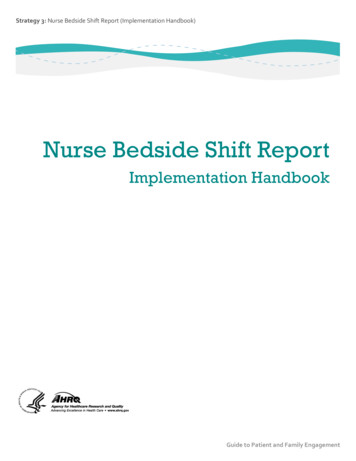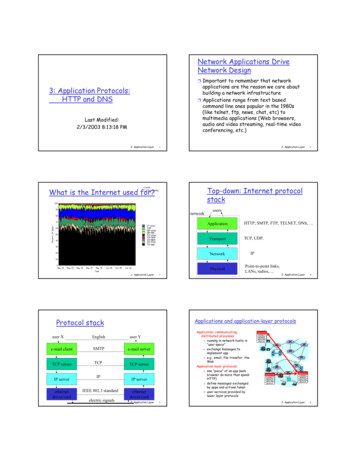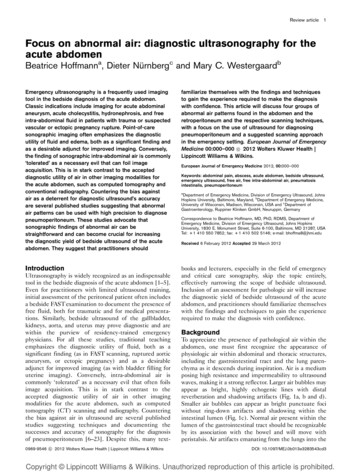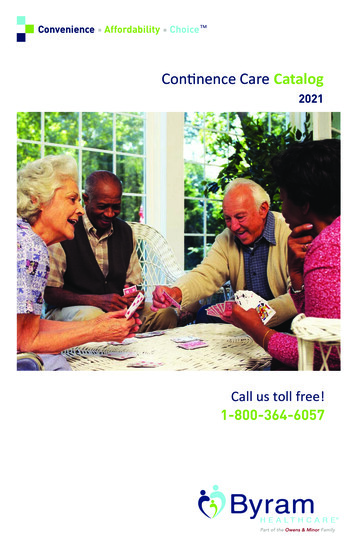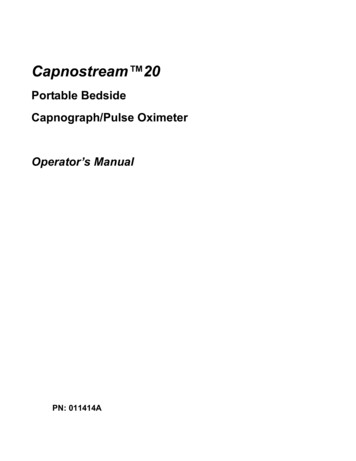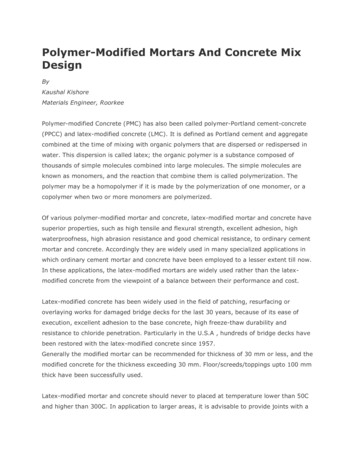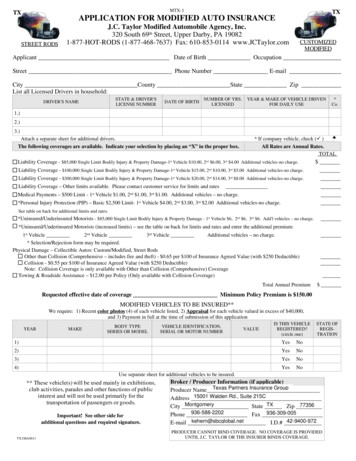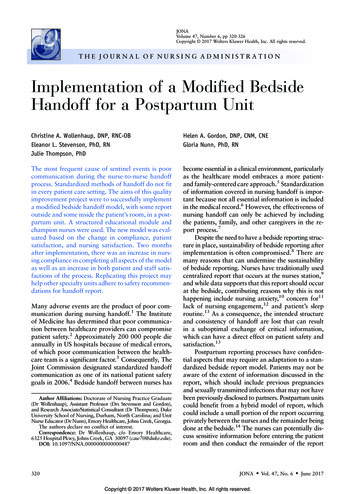
Transcription
JONAVolume 47, Number 6, pp 320-326Copyright B 2017 Wolters Kluwer Health, Inc. All rights reserved.THE JOURNAL OF NURSING ADMINISTRATIONImplementation of a Modified BedsideHandoff for a Postpartum UnitChristine A. Wollenhaup, DNP, RNC-OBEleanor L. Stevenson, PhD, RNJulie Thompson, PhDHelen A. Gordon, DNP, CNM, CNEGloria Nunn, PhD, RNThe most frequent cause of sentinel events is poorcommunication during the nurse-to-nurse handoffprocess. Standardized methods of handoff do not fitin every patient care setting. The aims of this qualityimprovement project were to successfully implementa modified bedside handoff model, with some reportoutside and some inside the patient’s room, in a postpartum unit. A structured educational module andchampion nurses were used. The new model was evaluated based on the change in compliance, patientsatisfaction, and nursing satisfaction. Two monthsafter implementation, there was an increase in nursing compliance in completing all aspects of the modelas well as an increase in both patient and staff satisfactions of the process. Replicating this project mayhelp other specialty units adhere to safety recommendations for handoff report.become essential in a clinical environment, particularlyas the healthcare model embraces a more patientand family-centered care approach.5 Standardizationof information covered in nursing handoff is important because not all essential information is includedin the medical record.6 However, the effectiveness ofnursing handoff can only be achieved by includingthe patients, family, and other caregivers in the report process.7Despite the need to have a bedside reporting structure in place, sustainability of bedside reporting afterimplementation is often compromised.8 There aremany reasons that can undermine the sustainabilityof bedside reporting. Nurses have traditionally usedcentralized report that occurs at the nurses station,9and while data supports that this report should occurat the bedside, contributing reasons why this is nothappening include nursing anxiety,10 concern for11lack of nursing engagement,12 and patient’s sleeproutine.13 As a consequence, the intended structureand consistency of handoff are lost that can resultin a suboptimal exchange of critical information,which can have a direct effect on patient safety andsatisfaction.13Postpartum reporting processes have confidential aspects that may require an adaptation to a standardized bedside report model. Patients may not beaware of the extent of information discussed in thereport, which should include previous pregnanciesand sexually transmitted infections that may not havebeen previously disclosed to partners. Postpartum unitscould benefit from a hybrid model of report, whichcould include a small portion of the report occurringprivately between the nurses and the remainder beingdone at the bedside.14 The nurses can potentially discuss sensitive information before entering the patientroom and then conduct the remainder of the reportMany adverse events are the product of poor communication during nursing handoff.1 The Instituteof Medicine has determined that poor communication between healthcare providers can compromisepatient safety.2 Approximately 200 000 people dieannually in US hospitals because of medical errors,of which poor communication between the healthcare team is a significant factor.3 Consequently, TheJoint Commission designated standardized handoffcommunication as one of its national patient safetygoals in 2006.4 Bedside handoff between nurses hasAuthor Affiliations: Doctorate of Nursing Practice Graduate(Dr Wollenhaup), Assistant Professor (Drs Stevenson and Gordon),and Research Associate/Statistical Consultant (Dr Thompson), DukeUniversity School of Nursing, Durham, North Carolina; and UnitNurse Educator (Dr Nunn), Emory Healthcare, Johns Creek, Georgia.The authors declare no conflict of interest.Correspondence: Dr Wollenhaup, c/o Emory Healthcare,6325 Hospital Pkwy, Johns Creek, GA 30097 (caw70@duke.edu).DOI: 10.1097/NNA.0000000000000487320JONA Vol. 47, No. 6 June 2017Copyright 2017 Wolters Kluwer Health, Inc. All rights reserved.
at the bedside.15 The patient and family (if patientconsents) should be included in the bedside reportand the creation of patient goals for that shift.16 Thisencourages active participation of the patient andfamily in their care. The patient and family shouldalso be given the opportunity to ask questions relatedto the handoff discussion and the plan of care.17This quality improvement project (QIP) used components of the Situation, Background, Assessment, andRecommendation (SBAR) method of report because itis the adapted policy in the other patient care settingswithin the project facility. Bedside reporting structurewas in place in the postpartum unit in which the QIPwas implemented; however, audits of the processrevealed that the staff was only using selected components of the handoff and the partial reporting outside of the room was not part of the approved processbefore the QIP.Once implemented, the QIP structure includedhandoff being conducted both outside of the roomand at the bedside. The following components wereincluded: review of electronic medical record (computer), SBAR, and development of goals.18 The situation and background components occurred privatelybetween the 2 nurses, and the remainder of the reportoccurred at the bedside. Upon entering the patientroom, the offgoing nurse introduced the oncomingnurse and encouraged the patient to participate inreport. If the patient consented to family membersbeing present during handoff, they were permittedto stay in the room and were included in the reporting process. After the determination of the patient’sgoal for the shift and discussion of the dischargegoal, the final component of report was allowingthe patient and family to ask questions.18 A Modified Bedside Handoff Tool (Figure 1) was createdas a guideline for the staff to ensure that all components were included.The primary aim of this QIP was to increasethe compliance of all 7 components of the modifiedbedside handoff as indicated on the Modified Bedside Handoff Tool (Figure 1). The secondary aim wasto improve patient and nurse satisfaction with bedside reporting through developing, implementing, andevaluating the use an SBAR structure of hybrid bedside handoff between nurses on a postpartum unit.Target outcomes for implementation includingthe following:1. Measure nursing compliance of the 7 components of the modified bedside handoffusing the Modified Bedside Handoff Tool(Table 1) before implementation and observean increase to 95% compliance 2 months afterimplementation.2. Observe an increased patient satisfaction withbedside reporting by 20% as measured withthe Patient Satisfaction Questionnaire (Figure 2)before the innovation and within 2 monthspostimplementation.3. Observe an increased nurses’ satisfaction withbedside reporting by 10% as measured withthe Nursing Satisfaction Questionnaire (Figure 3)before the innovation and within 2 monthspostimplementation.Project MethodsDesignThe setting was a 13-bed postpartum unit in a 110-bedrural hospital. At the beginning of the project, all nurses(N 28) were eligible to participate in the trainingfor the modified bedside format and assessment ofsatisfaction in bedside reporting. The QIP used quantitative data collection to ascertain if target outcomeswere met. A preimplementation/postimplementationdesign measured frequency of nursing compliance usingthe modified bedside shift report as well as levels ofpatient and staff satisfaction with bedside reporting.A convenience sample (N 50) of postpartum patientswas used to assess patient satisfaction with bedsidereporting. Inclusion criteria included being a femalepatient of childbearing age, in the first few dayspostpartum before discharge from the postpartumunit, and having delivered a viable infant during thecurrent hospital stay. The project excluded motherswith babies in the special care nursery and patientsrequiring an interpreter for communication.Project ChampionsProject champions were developed to support nursing staff after the educational phase and through theimplementation of the project. The champions wereessential to engaging staff in best practices becausestaff prefer education from their peers over othermethods of education.19 The project leader trained 2champions from both day and night shifts who werefull-time employees of the hospital. The championswere educated on use of the tool (Figure 1) for thereporting process. The champions provided guidanceand support to the staff during implementation andcontinuation of bedside shift handoff.EducationBecause bedside reporting had previously been implemented on this unit without success, the QIP wasimplemented using Lewin’s Theory of Change.20 Thefirst step was unfreezing the current process. The changeswere implemented, and the refreezing process began.JONA Vol. 47, No. 6 June 2017Copyright 2017 Wolters Kluwer Health, Inc. All rights reserved.321
Figure 1. Modified bedside handoff tool.One of the challenges of sustainability of postpartumbedside reporting had been lack of support by staffto fully understand the significance of the practice.To create sustainability of bedside handoff, the implementation began with a formal education programfor the nurses to cover the benefits derived from including patients and families in the reporting process.The education sessions were conducted over 2 weeksto teach the staff the expected structure of handoff andthe benefits reported in the literature. The currenthospitalwide bedside model being used was adaptedto be specific for the postpartum unit and included322partial reporting of sensitive health information outside of the room, thus creating the hybrid SBAR modelpreviously described. The bedside handoff guidelines(Figure 1) were added to the mobile computer workstations that the nurses used during report. This provided a ready reference for the nurses when conductingreport. During the project, the lead author (C.A.W.) andthe champions were available daily during the reporttime to assist staff with questions and coach themthrough challenges. Weekly discussions were held withthe postpartum nurses to elicit feedback on the progressof the modified handoff and offer support to the staff.JONA Vol. 47, No. 6 June 2017Copyright 2017 Wolters Kluwer Health, Inc. All rights reserved.
Table 1. Frequency and Percent of ChecklistItems completed by Preimplementation andPostimplementationChecklist terRecommendationsQuestionsAll 7 items completePre n (%) Post n (84)Fisher’s exactP valueno change.20no change.16G.001.07G.001G.001Data Collection and MeasuresInitial data with bedside handoff requirements werecollected on the 7 components indicated in the Modified Bedside Handoff Tool (Figure 1). The tool dividesthe necessary components of report into 7 areas. Thelead author (C.A.W.) and the champions completedaudits of the handoff process and used the tool torecord compliance. Collectively, they observed 50 bedside handoffs and documented whether each of the 7necessary components was completed. Compliance wasmeasured by calculating the number of times each of the7 major components was completed during the handoffprocess, which was reflected as a percentage of the totalnumber of audits. Two months postimplementation ofthe QIP, an additional 50 nursing handoffs were auditedin the same manner to determine if there was a changein the usage of bedside reporting.The patient and staff satisfactions with bedsideshift handoff were measured by 2 different questionnaires:a Patient Satisfaction Questionnaire (Figure 2) and aStaff Satisfaction Questionnaire (Figure 3). The ques-tionnaires were developed by the lead author basedon information collected during the literature review.The data collection was conducted by the lead authorand the champions. A 5-item Patient Satisfaction Questionnaire (Figure 2) was collected from 50 patientsbefore the implementation of the QIP, and additional50 patients were surveyed 2 months postimplementation to determine if there was a change in patientsatisfaction with the handoff process. The questionswere answered via a 7-point Likert scale,21 (1, lowlevel of satisfaction and 7, high level of satisfaction),with a total possible score of 35, and higher totalscores indicating greater levels of satisfaction. Thesurvey was conducted verbally by the departmentdirector during intentional leadership rounding thatoccurs once each day on the postpartum unit andcaptured on a paper questionnaire. The Staff Satisfaction Questionnaire (Figure 3) was used to assessstaff satisfaction with the modified structure of handoff. Before any of the training sessions, questions wereanswered by staff via a 7-point Likert scale,21 (1, lowlevel of satisfaction and 7, high level of satisfaction)with a total possible score of 35, and higher totalscores indicating greater levels of satisfaction. Theanonymous paper-and-pencil questionnaire was distributed to the staff members before implementationof the innovation and collected on their completion.The paper-and-pencil questionnaire was given to staffagain 2 months postimplementation.Data AnalysisAll data were entered by the lead author into IBMSPSS (Armonk, New York) and analyzed using SPSSversion 21 software. To evaluate the percentage ofcompleted checklist items at preimplementation andFigure 2. Patient satisfaction questionnaire.JONA Vol. 47, No. 6 June 2017Copyright 2017 Wolters Kluwer Health, Inc. All rights reserved.323
Figure 3. Nursing satisfaction questionnaire.postimplementation, a series of Fisher’s exact testswere conducted for each individual item and for thepercentage of handoffs that completed all 7 items. Atest of change was not conducted for the backgroundor situation components of handoff because theseitems were completed for all handoffs at both preimplementation and postimplementation.Preimplementation and postimplementation patient and nurse satisfaction scores were comparedusing a series of independent sample t tests conductedfor each individual item and for the total of all 5 questions to determine the overall satisfaction score for bothpatient and nurse satisfactions. The percentage changewas calculated based on the predata/postdata scoresand t test P value.ResultsThe first target outcome of this QIP was to increasenursing compliance of the 7 components of the modified bedside shift handoff to 95%. There was a statistically significant increase in compliance of all 7 itemsof the handoff being complete (pre 26%, post 84%,P G.001), which indicating an increased complianceby the nurses in incorporating all of the identifiedcomponents of handoff into their report (Table 1).The background and situation components had 100%compliance before and after the innovation.Additional target outcomes were to increase patient satisfaction with bedside handoff by 20% andnurses’ satisfaction with bedside handoff by 10% within2 months postimplementation. There were significant increases in reported satisfaction for all itemsevaluated for both patients and nurses (Tables 2 and 3).Patient satisfaction scores increased by 28.01%, withP of less than .001. Staff satisfaction scores increasedby 40.34%, with P value of less than .001. Both patientand staff satisfaction increased after the project implementation with statistical significance.DiscussionCompliance of nurses in completing all necessarycomponents of bedside handoff increased as a resultTable 2. Independent t Test Results for Patient Satisfaction Survey Items (N 100)ItemHow often do you feel that you are included in your plan of care?How often were you asked about your goal for the day/shift?How often did the nurses discuss your discharge goal with you atchange of shift?How often did you feel comfortable to ask questions about your care?We change shifts twice a day. How often is the staff includingyou in the report?Total324Pre (n 50),M (SD)Post (n 50),M (SD)t Test Pvalue5.04 (1.71)5.08 (1.10)4.62 (1.66)6.42 (.81)6.86 (.40)6.22 (.86)G.001G.001G.0015.64 (1.12)6.08 (1.21)6.72 (.70)6.86 (.50)G.001G.0014.58 (.58)5.85 (.29)G.001%Change28.01JONA Vol. 47, No. 6 June 2017Copyright 2017 Wolters Kluwer Health, Inc. All rights reserved.
Table 3. Independent t test Results for Nurse Satisfaction Survey Items (N 56)ItemHow comfortable do you feel engaging patients and families toparticipate in bedside shift report?How often do you include the patients and families in thereporting process?How would you rate the value of bedside shift report?How often do the patients and families participate in the bedsidereporting process?How often do you leave work on or before the end of the shift (7:30)?Totalof the modified structure of handoff. The predataindicated that there was only a 26% compliance ofcompleting all of the identified components of themodified bedside handoff. Providing a structurededucational approach to support the use of the modified bedside handoff increased engagement in theprocess. It also has the potential to create a saferpatient environment by decreasing communicationerrors.8 This approach is 1 strategy to implementnew initiatives in patient care units.13 In addition,the incorporation of champions was used to be aresource for staff and audit the compliance withthe modified handoff. The champions are beneficial because staff prefer to learn from colleaguesthan from other methods.19 Using champions foreducation and support may have contributed to nursing engagement in the QIP and increased compliancewith the process. Postdata collection revealed nursing compliance in completing all 7 components ofbedside handoff at 84%. Although the project aim of95% was not achieved, there was significant increasein the compliance. Continued observation and reinforcement of the process will further help to increasethe compliance of completing all necessary components of the modified handoff.17An additional aim of the project was to increasethe patient satisfaction scores by 20%, which wasexceeded, with postimplementation scores increasingby 28.01%. Increased patient satisfaction scores area typical result of the introduction of bedside handoffbecause the patients feel more involved with their care.17Patient satisfaction also increased because the nursesincluded them in their daily and discharge goals.The final aim was to increase staff satisfactionwith bedside handoff by 10%, which resulted in anincrease of 40.3%, far exceeding the project goals.Literature review during education sessions reinforced the benefits of conducting handoff at thebedside, which supported staff buy-in to the process.8 In addition, the Modified Bedside HandoffPre (n 28),M (SD)Post (n 28),M (SD)t Test Pvalue4.68 (1.66)6.25 (.80)G.0014.36 (1.59)6.07 (.94)G.0014.29 (1.38)3.46 (1.07)5.82 (1.28)5.64 (1.16)G.001G.0013.68 (1.47)4.09 (1.38)4.93 (1.86)5.74 (.81)G.01G.001%Change40.34Tool gave staff a structured format to follow forhandoff and helped to eliminate unnecessary andtime-consuming discussions that would lead to longerreporting times.22LimitationsThere are limitations that may affect the results ofthis project. The primary author’s (C.A.W.) place ofemployment was self-selected as the project site, anda convenience sample of patients and staff was used.This can limit the project based on the socioeconomicand ethnic characteristics of the patients and nursesin this population. In addition, there may be somedifferences in the outcomes due to the atmosphereand workflow of a small hospital environment. Thesesame steps should be trialed in other unique caresettings and larger facilities for application.ConclusionLiterature reflects that using a bedside handoff process results in better patient outcomes. Educating staff,using champions, and creating a modified bedsidehandoff tool during implementation resulted in anincreased compliance by nurses of inclusion of allnecessary components of handoff. The QIP incorporated a modified handoff model in a postpartum unitallowed the nurses to use a SBAR structure whileprotecting potentially sensitive information yet stillsupporting family-centered care. The data from thisproject support a successful implementation of thisnursing handoff structure that also increased bothpatient satisfaction and staff satisfaction. A modifiednursing handoff that allowed for private discussionof sensitive information before conducting the remainder of handoff at the bedside resulted in increasedsatisfaction of both patients and staff but requirescontinued monitoring and support to sustain thisprocess.22JONA Vol. 47, No. 6 June 2017Copyright 2017 Wolters Kluwer Health, Inc. All rights reserved.325
References1. Kerr D, Lu S, McKinlay L. Bedside handover enhances completion of nursing care and documentation. J Nurs Care Qual.2013;28(3):217-225.2. Institute of Medicine. Crossing the Quality Chasm: A NewHeath System for the 21st Century. Washington, DC: NationalAcademies Press; 2001.3. Martin HA, Ciurzynski SM. Situation, background, assessment, and recommendation-guided huddles improve communication and teamwork in the emergency department. J EmergNurs. 2015;41(6):484-488.4. The Joint Commission. Improving America’s Hospitals. TheJoint Commission Web site. http://www.jointcommission.org/assets/1/6/2007 Annual Report.pdf.5. Chaboyer W, McMurray A, Wallis M. Bedside nursing handover: a case study. Int J Nurs Pract. 2010;16(1):27-34.6. Bates KE, Bird GL, Shea JA, Apkon M, Shaddy RE, Metlay JP. Atool to measure shared clinical understanding following handoffsto help evaluate handoff quality. J Hosp Med. 2014;9(3):142-147.7. Lu S, Kerr D, McKinlay L. Bedside nursing handover: patients’opinions. Int J Nurs Pract. 2014;20(4):451-459.8. Gregory S, Tan D, Tilrico M, Edwardson N, Gamm L. Bedside shift reports: what does the evidence say? J Nurs Adm.2014;44(10):541-545.9. Radtke K. Improving patient satisfaction with nursing communication using bedside shift report. Clin Nurse Spec. 2013;27(1):19-25.10. Kerr D, McKay K, Klim S, Kelly AM, McCann T. Attitudesof emergency department patients about handover at thebedside. J Clin Nurs. 2014;23(11-12):1685-1693.11. Evans AM, Pereira DA, Parker JM. Discourses of anxiety innursing practice: a psychoanalytic case study of the changeof-shift handover ritual. Nurs Inq. 2008;15(1):40-48.32612. Wakefield DS, Ragan R, Brandt J, Tregnago M. Making thetransition to nursing bedside shift reports. Jt Comm J QualPatient Saf. 2012;38(6):243-253.13. Griffin T. Bringing change-of-shift report to the bedside: apatient- and family-centered approach. J Perinat Neonatal Nurs.2010;24(4):348-353; quiz 354-355.14. Sand-Jecklin K, Sherman J. Incorporating bedside report intonursing handoff: evaluation of change in practice. J Nurs CareQual. 2013;28(2):186-194.15. Sherman J, Sand-Jecklin K, Johnson J. Investigating bedsidenursing report: a synthesis of the literature. Medsurg Nurs.2013;22(5):308-312, 318.16. Anderson CD, Mangino RR. Nurse shift report: who saysyou can’t talk in front of the patient? Nurs Adm Q. 2006;30(2):112-122.17. Baker SJ. Bedside shift report improves patient safety andnurse accountability. J Emerg Nurs. 2010;36(4):355-358.18. American Hospital Association. Bedside change-of-shift reporting at Emory Healthcare. Engaging Health Care Users:a framework for healthy individuals and communities.2013;38.19. White CL. Nurse champions: a key role in bridging the gapbetween research and practice. J Emerg Nurs. 2011;37(4):386-387.20. Oberleitner MG. Theories, models, and frameworks fromadministration and management. In: McEwen M, Wills EM.Theoretical Basis for Nursing. 3rd ed. Philadelphia, PA: WoltersKluwer Health; 2011:337-338.21. Likert R. A technique for the measurement of attitudes. ArchPsychol. 1932;140:1-55.22. Cairns LL, Dudjak LA, Hoffmann RL, Lorenz HL. Utilizingbedside shift report to improve the effectiveness of shift handoff. J Nurs Adm. 2013;43(3):160-165.JONA Vol. 47, No. 6 June 2017Copyright 2017 Wolters Kluwer Health, Inc. All rights reserved.
satisfaction with the handoff process. The questions were answered via a 7-point Likert scale,21 (1, low level of satisfaction and 7, high level of satisfaction), with a total possible score of 35, and higher total scores indicating greater levels of satisfaction. The survey was conducted verbally by the department
